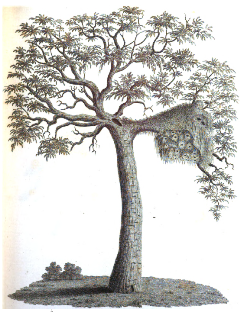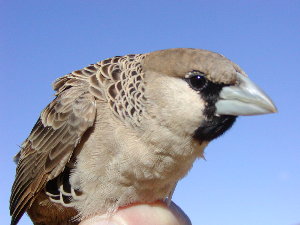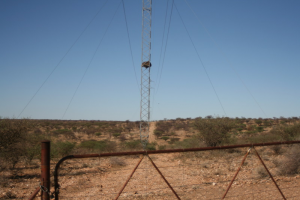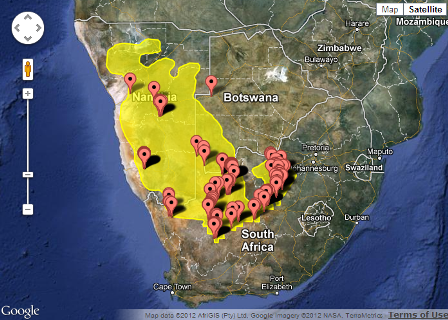Weaver species list / RELATED SPECIES: Black-capped Social Weaver / Grey-headed Social Weaver / Sociable Weaver
IUCN: Least concern Discovery: 020
Categories: cooperative, acacias, fruit, gum, Gymnogene, Nest use, Pseudonigrita+Philetairus
Discovery
  
IntroductionThe Sociable Weaver was formally described by John Latham, a Scottish explorer. Latham based the details on a travel book by William Paterson, a Scottish soldier and explorer. Paterson was sent to the Cape Colony to collect plants, and he made four trips into the interior between May 1777 and March 1780. In his published narrative, he wrote mostly about plants and rarely about animals. However, on his journey to the Orange River in 1779, he described a giraffe and the Sociable Weaver.Paterson provided the first description and illustrations of the Sociable Weaver and its massive communal nest. He compared the nest to a thatched roof which he considered an “aerial city”. He saw many large nests and estimated one to have 800-1000 birds living in it. Paterson wrote about the Sociable Weaver in December 1779 after having returned from Namibia, so the exact locality is not clear. He noted that he saw the weavers and nests soon after seeing giraffe, and he would have seen the nests north of the Orange River between Goodhouse and Warmbad, during October 1779. The type locality was restricted to Warmbad for convenience. Soon after Paterson’s journey, Le Vaillant travelled to the Orange River and also illustrated and wrote about the Sociable Weaver. He collected the first Rosy-faced Lovebirds, which he obtained at a Sociable Weaver colony. Le Vaillant thus was the first person to report weaver nests being used by non-weavers. Thereafter, many travellers in southern Africa wrote about the Sociable Weaver and its unique nest. Scientific citationLoxia socia Latham 1790 Index Ornith., vol. i, p.381 Capitis Bonae Spei interioribus [=Inland of Cape of Good Hope], restricted to Warmbad, southern Great Namaqualand, Namibia, by MacDonald 1957. Meaning of namessocius (Latin): sharing, allied [ie sociable]. First English nameSocial Grosbeak (Paterson 1789) Alternate namesRepublican Grosbeak, Sociable Grosbeak, Social Weaver. CollectorWilliam Paterson. Date collectedOctober 1779. Locality collectedCapitis Bonae Spei interioribus [=Inland of Cape of Good Hope], restricted to Warmbad, Namibia. Type specimensType specimen not known to exist; the illustration of Paterson 1789 serves as a type. |
The above is based on Weaver Wednesday 2, a weekly series about the discovery of each weaver species.
This species text first appeared as Weaver Wednesday [137] – Discovery [20]: Sociable Weaver on 2015-01-28
1. Basic biology

Identification. The Sociable Weaver Philetairus socius with its huge communal nest is the iconic feature of arid regions in southern Africa. Adults are distinctive with scaled upperparts and flanks, black bib and brown cap. Juveniles lack the bib.
Distribution. The distribution map (above) is based on The Atlas of southern African Birds, showing the current PHOWN records. There have been very slight range expansions at the edges of its range in some parts (e.g. see here), although the southernmost colony has not changed in 21 years (e.g. see here). The Sociable Weaver is expected to expand its range as climate change results in an expansion of the arid region in southern Africa. Several subspecies have been described for this species in the past, but are no longer considered valid. Habitat. This species is found in open, arid country with scattered trees. Food. It forages on the ground, feeding on seeds and insects, especially harvester termites. They forage within 1.5 km of their nest sites which they occupy year-round. Breeding. The nest of the Sociable Weaver is remarkable. It may be the largest nest in the avian world, although other contenders have been considered. Nests may be up to 7m diameter, with a weight up to 1 ton. The nests are built of dry grass and nest masses would not survive in areas of high rainfall. Birds huddle together in chambers on cold winter nights to raise the temperature within the chamber. During hot summer days, birds shelter in the cool shade of the chambers. Nest sites are mainly camel thorn trees but other tree species are also used, as is the quiver tree (photo below left, phown 1103). Man-made structures are often used, particularly telephone poles. Interesting nest sites were on a dilapidated rondavel (photo below center, phown 1030) and on windmill blades (photo below right, phown 1577).
Sociable Weaver nests provide shelter and nest sites for many other birds, particularly the Pygmy Falcon which is dependant on this weaver in southern Africa (e.g. see Tswalu survey). Some other species that regularly roost or breed in the Sociable Weaver nests are Acacia Pied Barbet, Rosy-faced Lovebirds and Red-headed Finches see photos here).
Ideally nest records submitted to PHOWN should include a nest count, where possible, to obtain a rough guide to the colony size. For Sociable Weavers, this means counting the individual chambers by walking underneath the nest mass. Presence of snakes, however, is a good reason not to count nest chambers – Cape Cobras often raid eggs and chicks in Sociable Weaver nests, as seen in this photo (from phown 2172). |
The above is based on Weaver Wednesday, a weekly series about weaver species.
This species text first appeared as Weaver Wednesday [16]: Sociable Weaver on 2012-10-03
2. Breeding facts
| Pair bond Monogamous, but successive nesting attempts often with different partners, even if former mate still present in colony. often breeds co-operatively, with up to nine helpers (both adults and young) Breeding season Nest site Nest building Colony size Clutch size Egg colour Egg size Incubation Chicks and nestling period |
Breeding information based on Handbook of the Birds of the World, Vol. 15.
3. Photos of Weaver Nests
 Vm 29304 |
 Vm 29300 |
 Vm 29291 |
 Vm 29285 |
 Vm 29284 |
 Vm 29281 |
Thumb-nails of recent PHOWN records





